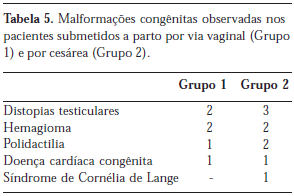An evaluation of infant morbimortality and mother morbidity was undertaken according to the type of delivery. A prospective study was undertaken on 170 puerperal patients divided into two groups: Group 1 (n = 95), natural or vaginal delivery, Group 2 (n = 75), submitted to caesarean delivery. Complications in mothers were classified in small, moderate and severe. The infant parameters were: period of pregnancy, weight on birth, Apgar score, necessity of intensive care and neurological disorders. Mothers who had not completed elementary school (p=0.0045) had more vaginal delivery. Previous vaginal deliveries were more common in Group 1 than caesarean section in Group 2 (p = < 0.001) (OR = 104.00; 21.11 < OR < 610.99). In Group 1, vaginal delivery was preferred by 78 (82,1%) of mothers comparing to 28 (37.3%) from Group 2, who preferred caesarean section (p = 0.0002) (OR = 4; 1.77 < OR < 9.17). Post-operative was more intense and frequent after caesarean section (8 cases) than patients of Group 1 (2 cases) (p = 0.018) (OR = 0.18; 0.03 < OR < 0.96). Obstetric trauma was found in 14 deliveries of Group 1 and 7 of Group 2 (p = 0.28). Infant hospitalization was greater in Group 2 (3.43 +/- 0.70 days) in comparison with Group 1 (2.71 +/- 0.67 days) (p < 0.0001). The infant morbidity was greater after vaginal deliveries, but maternal morbidity was greater after caesarean deliveries.
Infant; Parturient; Morbidity; Vaginal delivery; Caesarean delivery





